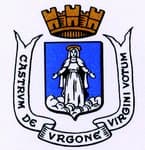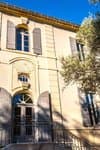
Alpilles Roquemartine by bike: the variant of Orgon
This colorful loop, offers you to stroll through the varied landscapes offered by the Regional Natural Park. In addition to taking you into the heart of the Alpilles and taking you to the Luberon, you will also cross different towns, lively and warm, perfect places for a meal, a small snack or a sweet break..
11 points of interest

A la découverte du calcaire - ©Fabrice Aubert - Musée Urgonia  Patrimony and history
Patrimony and historyUrgonia museum
Discover the heritage of the territory through the exhibition in geology, palaeontology, archaeology and ornithology presented in the former prison. This historic place still bears graffiti made by the prisoners. It reveals the unique and fascinating history of this land from 130 million years ago. As a highlight, discover the urgonian limestone and its numerous fossils which has been giving this eponymous site an international resonance since the mid 19th century.
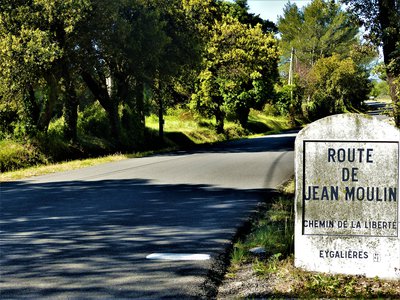
Borne de la route de Jean Moulin - ©Rémi Sérange - PNR Alpilles  Patrimony and history
Patrimony and historyJean Moulin Road, Freedom Road
This road was inaugurated in 1978, nine years after the memorial at Salon-de-Provence which also pays tribute to Jean Moulin. It leaves Saint-Andiol and ends in Salon-de-Provence. Very attached to the Alpilles, where he owned a small country house, Jean Moulin chose this familiar land to be parachuted and to begin his mission of unification of resistance network of the unoccupied France.
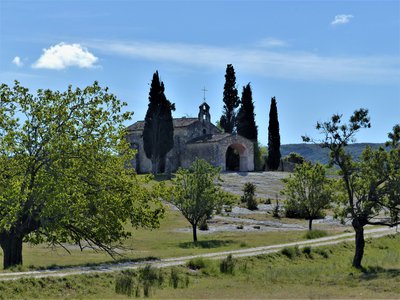
Chapelle Saint-Sixte - ©Rémi Sérange - PNR Alpilles  Patrimony and history
Patrimony and historySaint Sixtus Chapel
His name refers to Sixtus II, contemporary of St. Lawrence and pope of early Christian times. The chapel is located on an old place of worship: until the nineteenth century, it housed a pagan stele, which was then used as foot of holy water. The latter reflected a cult dedicated to the water. The first reference that is made regarding the chapel date of 1155. Significant changes were made in the sixteenth century. and seventeenth century, because it served as a lazaretto during the plagues of 1629 and 1720.
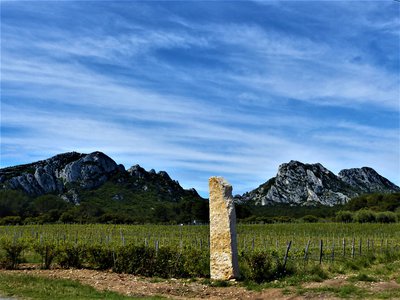
Le Calan de Rousset - ©Rémi Sérange - PNR Alpilles  Panorama
PanoramaView on the Calans
Here, the relief of the Alpilles is similar to limestone rocks forming a natural barrier. The latter limits access to the heart of the massif to small passages like the Pas du Suisse. On the left is the famous Calan de Rousset, isolated from the rest of the massif and 275 meters high.

Entrée du domaine - ©Jason Gaydier - PNR Alpilles  Produits du terroir
Produits du terroirThe Vallongue farmhouse
Located at the southeast end of the Alpilles ridges, the Vallongue domain has 38 hectares on which is produced wines and olive oils. These vineyards were the first to turn to organic farming, as of 1985! Reds, whites and rosés benefitted from Les Baux de Provence Appelation d'Origine Protégée (AOP) label and Alpilles of Vallongue Indicateur Géographique Protégé (IGP) label, proof a real know-how.

Vue sur les Civadières - ©Rémi Sérange - PNR Alpilles  Panorama
PanoramaView of the Civadières
Located in the immediate vicinity of the highest point of the Alpilles, the crests of Civadières, high of 446 m offer a broad panorama on the solid mass of Alpilles, Petit Luberon and Mont Ventoux. They are part of the most ancient geological formations of the Park, dating back from the Jurassic. ;
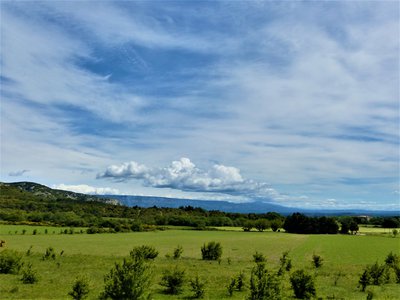
La plaine de Roquemartine - ©Rémi Sérange - PNR Alpilles  Panorama
PanoramaView on the Roquemartine lowland
This opening of the landscape, which follows a pine forest, reveals the Roquemartine lowland. It is between the eastern end of the Alpilles on the left and Mont Menu and Defens on the right. In the distance, one can also distinguish very clearly the first reliefs of the Petit Luberon. It forms a landscape where each element composes a harmonious whole, of a great serenity.

Château de Roquemartine - ©Rémi Sérange - PNR Alpilles  Patrimony and history
Patrimony and historyRoquemartine castle
Also called "Queen Jeanne Castle", it dates from the twelfth century and belonged to the family of Alba. Below is the Church Saint-Sauveur, which was formerly the parish church of Roquemartine village. The castle and the church form an original landscape perched on a spur overlooking the lowland below. At the beginning of the seventeenth century, the castle is abandoned in favor of the New Roquemartine castle, in lowland. This site has been registered with the historical monuments in 1926.

Plantation de fruitiers entourée de haies - ©Rémi Sérange - PNR Alpilles  Savoir-faire
Savoir-faireProvençales hedges
Symbols of Provence, many hedges segment the territory and separate the various plots. Composed of cedar or cypress, these hedges have the primary function of protecting the various crops from mistral and frost. These trees are also known for their wood, very solid and fragrant, and have served to build the framework of many farmhouses of the Alpilles.

Chapelle Notre-Dame-de-Beauregard - ©Rémi Sérange - PNR Alpilles  Panorama
PanoramaView on the Notre-Dame de Beauregard Chapel
Place of Christian pilgrimage today, this promontory is a place of worship probably since the protohistory. Many vestiges of the altars were found on the site. The current chapel was erected in 1878 on the site of a chapel that had become too small to accommodate pilgrims. Many ex-voto testify to a great religious fervor granted to this place The building below is a former convent built by the Augustinians Déchaussés (17th century).
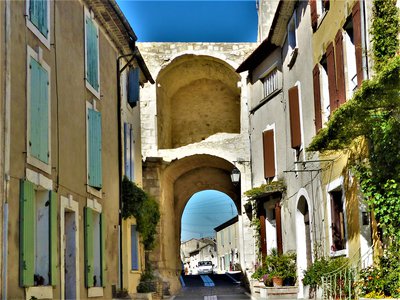
Intérieur de la porte Sainte-Anne - ©Rémi Sérange - PNR Alpilles  Patrimony and history
Patrimony and historyMedieval Gate Sainte-Anne
West entrance of the second enclosure of Orgon, it is difficult to estimate exactly its age. But we know that it has seen many important personalities since the sixteenth century. Notably, François 1st, who returned from Italy in 1516, stopped a few hours before continuing to Tarascon; Pope Pius VII, who will stay in Orgon and was lodged at the Berne Hotel No. 13 rue Edmond Coste; or Napoleon I, who passed through Orgon to go to Elba island.
Description
From the Urgonia museum, turn right. Continue on the left by the Paradis uphill then right by Jean Moulin Avenue.
1- Take the D24b on the left after the sports complex and continue until Eygalières for about 7 km. Cross the village and continue on the D24b to the junction with the D24.
2- Turn left on the D24, towards Mouriès. Continue for 2 km.
3- At the intersection with the D25, take it on the left, towards Eyguières Continue on this road for about 10 km.
4- (Caution, traffic!) Turn right on the D569, always towards Eyguières. At the roundabout, continue straight ahead for 150m.
5- Turn left in the direction of Sénas. Continue for 7 km.
6- cross the roundabout of the entrance of the city. 300 meters later, turn left on the path of "Donne", just before the level crossing. Continue to Orgon.
7- Go through Orgon by the Fontaine street then Edmond Coste street to reach the starting point at the Urgonia museum.
- Departure : Urgonia Museum, Orgon
- Arrival : Orgon
- Towns crossed : Orgon, Eygalières, Saint-Rémy-de-Provence, Aureille, Eyguières, Lamanon, and Sénas
Forecast
Altimetric profile
Recommandations
Follow the red and white signs marked "Alpilles Roquemartine" of the Bouches-du-Rhone Department
For your safety, and for the preservation of forest areas, access to natural areas is regulated from June to September. Inquire during the summer period on 08 11 20 13 13 (price of a local call) or on www.bouches-du-rhone.pref.gouv.fr Download the application for free MYPROVENCE ENVIE DE BALADE (available on Appstore and Android Market).
Information desks
Bureau d'information touristique (BIT) d'Orgon
Chemin des Aires, 13660 Orgon
House of the Alpilles Regional Nature Park
2, boulevard Marceau, 13210 Saint-Rémy-de-Provence
Located in the heart of the city centre of Saint-Rémy-de-Provence, the House of the Alpilles Nature Park welcomes you to its completely renovated premises. This new vibrant place is multifunctional: it accommodates the Park's engineering team but also has a public reception space and showrooms. A true resource centre of the Park's heritage, it aims to support and promote locals, visitors and tourists on all 16 municipalities of the Park.
Open Monday to Friday, from 9 am at 12:30 pm and from 1:30 pm to 5 pm.
Free admission.
Transport
Look for public transport times on the site www.lepilote.com in the town of Orgon.
Access and parking
From the D7n, follow the signage "Musée Urgonia".
Parking :
Report a problem or an error
If you have found an error on this page or if you have noticed any problems during your hike, please report them to us here:

